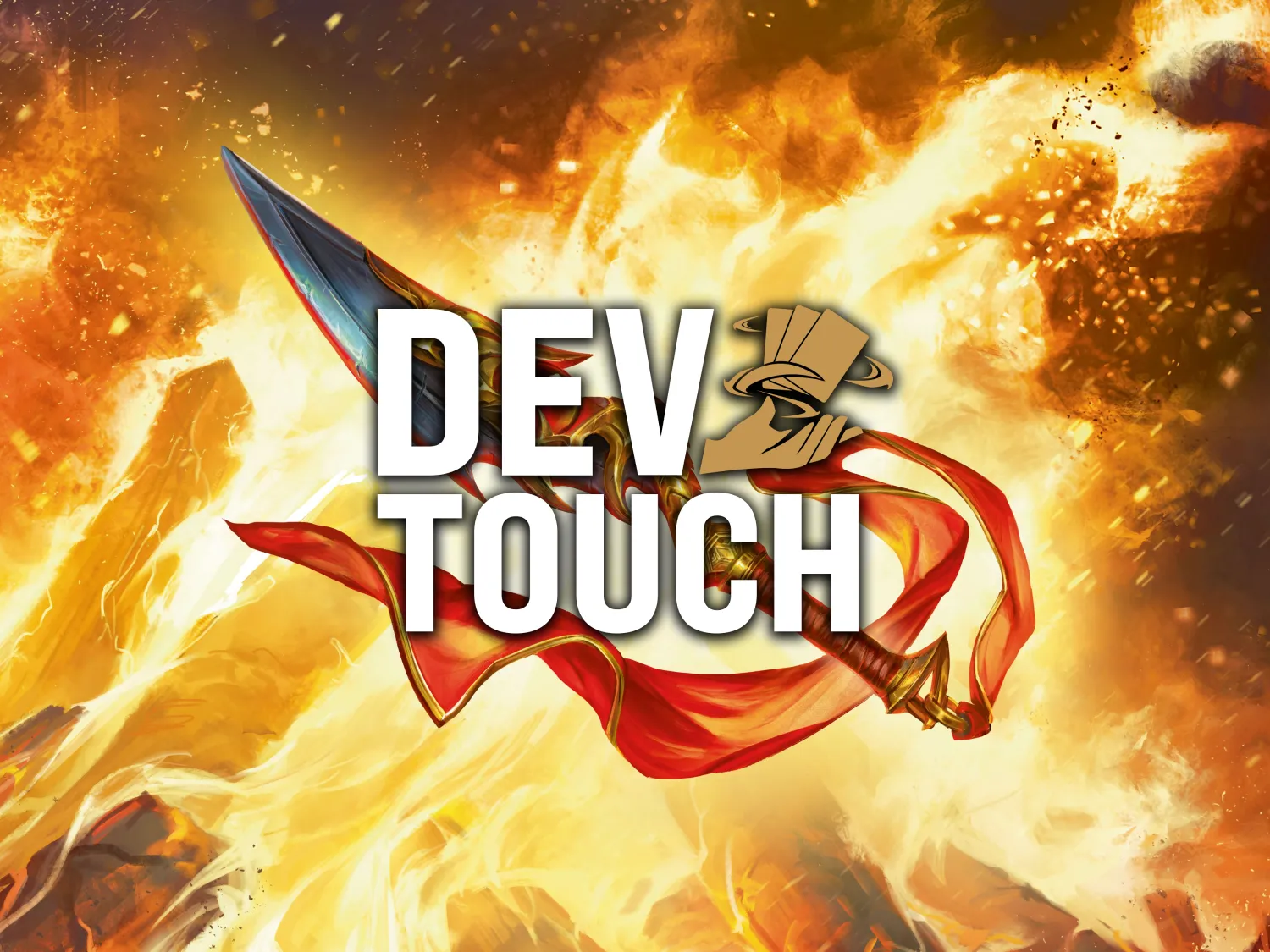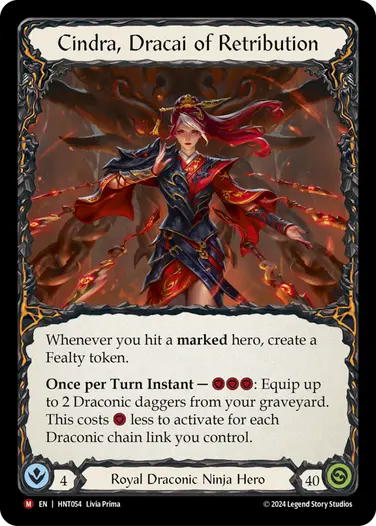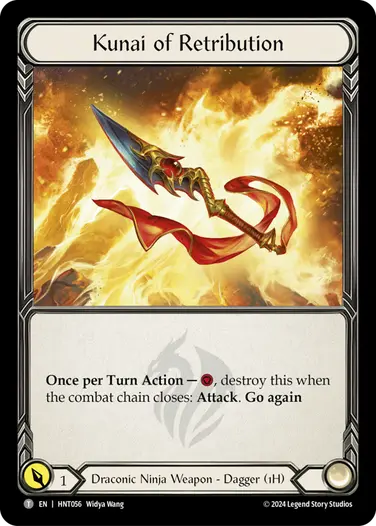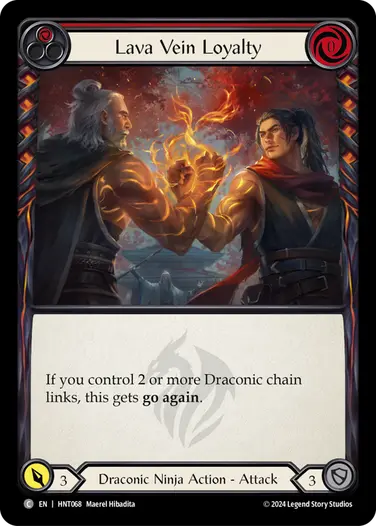Legend Story Studios developer Karol lifts the curtain of the Dev Room so we can take a peek behind the scenes. Learn about the work that went into designing, testing, and evolving the iconic cards you know and love today. Sometimes all a card needs to be great is a Dev Touch!
Simple designs are often the hardest to make. The same thing is true for development. Delivering a set of cards with depth and strategic complexity, but with a clear, simple, and intuitive text box is one of the hardest parts of the job. When it comes to design, in many trading card games it's the commons that often cause the most headaches. They need to be short, simple, and able to convey the overarching theme of the set.
Development-wise, they also have the least wiggle room to adjust. In Flesh and Blood, this is even more evident in heroes and weapons, especially when they are a core part of the hero's turn-by-turn play patterns. Today's tale talks about simplicity in design of heroes and weapons, and how often this mantra is important to keep in mind throughout the whole development pipeline.

I previously talked about Arakni, Marionette and the challenges the Chaos Assassin presented for the Dev Room. However, it wasn't the only major challenge for us during The Hunted's pipeline. Some issues are a lot more subtle, which makes them much harder to identify - yet their consequences can be just as significant. Kunai of Retribution was a big one. It is a core piece of Cindra's engine, which has transformed multiple times over the course of the set's development, with the most significant change occurring almost at the very end of testing.
To give context on how the Kunai have changed over the course of The Hunted, it is crucial to note that early on and throughout development, Cindra's hero ability cost 4 resources to activate - with a cost reduction built in, of course. The cost reduction was tied directly to the number of Draconic chain links you controlled. This is reminiscent of Fai's hero ability - bringing back the Phoenix Flame each turn.
To me, this expands on existing themes within the Draconic talent. Building up Draconic chain links is evocative of building up an attack like an explosive volcano - with rupture as a previous mechanic reflecting this. Cindra continued this trend. Her hero ability becomes discounted as her Draconic power grows, while many of the cards from her toolkit rely on having another Draconic chain link to go again. On the surface, the play patterns seemed quite similar to Fai. However, the fleeting nature of Cindra's daggers, maximizing value from attacking, flicking, and retrieving them felt unique. This dagger management was Cindra's core play pattern, which we needed to get right.
Alpha Phase
Alpha Phase is an early development stage, where the new cards are quickly stress tested in a limited time, usually with a limited number of developers with a direct involvement from designers for quick iterations. This allows for a speedy identification of any major issues with the core design - most importantly the hero abilities and weapons, as these usually dictate the core play patterns of each hero. Designers can then quickly adjust any issues on the fly.
Alpha Phase testing can take many forms depending on the set, but usually a few games of Sealed Deck can illustrate what each hero is trying to achieve, by combining the core SIPSIPs (Start in Play / Stay in Play cards) with the map.
"Map" refers to the new card-pool introduced with the new set. We often refer to the different groupings of the new card-pool by different maps, e.g. the Ninja map, the Draconic map, the Generic map, etc.
During Alpha Phase testing, we tried two different versions of Kunai - the simple 1-cost version, and a cost reduction version that read as follows:
Kunai of Retribution
Draconic Ninja Weapon - Dagger (1H)
1{p}
Once per Turn Action — {r}{r}, destroy this when the combat chain closes: Attack. Go again
This costs {r} less to activate for each Draconic chain link you control.
The one thing that stood out about Cindra's play patterns and her map, was that she needed blues. Dagger management felt surprisingly resource hungry with both Kunai versions, especially with her hero ability costing 4 resources. A large chunk of her map is Draconic and thus red pitch only, meaning we needed to look more closely at her access to resources.
With the daggers self-destructing, a flat resource cost felt too hefty, so we concluded the Alpha Phase going with the latter version - cost reduction Kunai.
Main Development
It made sense at the time - getting to multiple chain links was a reward to swing the Kunai for free, and any dagger flicks were just free value. Also the tension with activating the 4-cost hero ability was real. Who wants to pay 2 resources for a dagger that's just going to die?
Other than small tweaks here and there, this was the hero ability and Kunai that we worked with for the majority of the pipeline. Constantly juggling the Ninja map around to make the play patterns smoother in limited, while trying to make sure the free Kunai attacks weren't too strong in constructed.
For weeks on end we tweaked with different cards to find the sweet spot, but we kept running into the same issues:
- Both constructed and limited had feast or famine turn cycles. If you had two Draconic chain links to start the turn off, Kunai felt smooth like butter. If you drew no starters, you needed 2 resources to attack for 1 to get your turn started - a hefty cost for an aggressive Ninja.
- With three permanents checking for cost reduction, the admin of planning out a turn was evident. Even with one Kunai discounting the other, their costs could vary and each chain link required multiple calculations. Add dagger flicks and breaking the chain to the mix, and trying to squeeze the most value became a real challenge.
A major change we tried was reducing Cindra's hero ability to 3-cost instead of 4. One of the biggest benefits of this was giving Cindra players more flexibility with closing the chain and getting both Kunai back. It was a cool play pattern in limited, but we found it significantly pushed Cindra's power level in constructed.
The chasm between her power level in limited and constructed was becoming more evident the more we played, and it was becoming tough to mend it through tweaking individual cards in the set.
One of the developers intimately involved in both our limited and constructed Cindra testing, Jason Lai, started floating a seemingly dangerous idea in the few final weeks of The Hunted's completion - what if we revert Kunai of Retribution to one of the first versions? Simple 1-cost, just like the old Harmonized Kodachis.
It's not an easy feat to convince the team of such a drastic change that late, but Jason presented some compelling arguments - locking in a cost can reduce the swingy value proposition, removing the "free" attacks in constructed and removing the burden of a 2-cost dagger attack in limited on a bricky hand with no starter. Removing the burden of cost reduction tracking was my personal favorite outcome of trying this change.
Luckily for Jason, the change actually fit really well into our constructed decks, and in limited we only needed minimal adjustments to make the cost curves and ratios fit.
Looking back, it feels like the main thing holding back the flat 1-cost daggers was the 4-cost hero power. After a few days, the change seemed so fitting, we didn't even consider going back.
In the end, it is often the solutions that seem so simple, so obvious in retrospect that turn out to make for the best designs. However, underneath the glaring simplicity, are hundreds of hours of tweaking the text box, the maps, the blue counts, the Draconic starters, and so on. There were two major takeaways for the Dev Room from this experience.
Firstly, don't ignore the simple design, sometimes bells and whistles don't enhance the experience - and can do quite the opposite. Secondly, when a problem is still persistent quite late in the pipeline, drastic changes can elevate a good design into a great design, but this has to be done with clearly set parameters.


